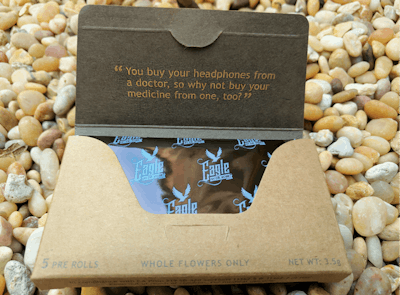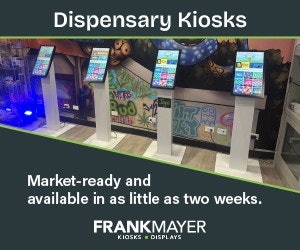
Fact: It’s not always easy—or even moderately easy—to get your cannabis products in front of a retailer, let alone onto a retailer’s shelves. But these tips from cultivators—who developed strong relationships with retailers in their states—should make it easier.
1. Consider your products’ backstory.
According to Robby Flannery, Ph.D., CEO and founder of Dr. Robb Farms in California, “the days of dispensary product managers being willing to accept pretty much anything that comes in off the streets are long gone—and they are not coming back.” This could paint a grim outlook for getting your product in a dispensary’s door. But an easy solution exists to this widespread problem: Sell your products’ story as much as you sell the products themselves.
“The most important thing that gets a cannabis product into the marketplace is something that has an interesting story behind it,” Flannery says. “If your product comes with an interesting backstory, that product is just much more marketable in the product manager’s eyes as well.” Practice your story-telling skills before you meet with a product manager, and ensure he or she won’t forget the story or the product.
2. Work with a partner.
When it comes to getting your products into a retailer, you have at least two options: Approach the product manager directly, hoping to score a sale, or work with an outside expert—one who already has a positive, long-standing relationship with area retailers and who can arrange to distribute your products for you. The latter is the sales method Dr. Robb Farms employs, and Flannery says it works well.
“The dispensary product manager is a difficult position to hold,” he says. “So, any time I can make their jobs easier, it behooves both myself and the product manager. By working with a distribution partner who has already vetted the products they distribute, I can help ease the product manager’s mind on the ability to keep the shelves stocked with said product, and also [prove] that our products are high quality.” Flannery adds that if your distribution partner has already developed a long-term relationship with the product manager, walking into a dispensary becomes much easier.

3. Master the art of the cold call.
“From my personal experience, cold calling is an art in-and-of itself,” says Zach Tynan, the director of sales for Delta Mantra in Oregon. As he describes, first, you have to know when to call. “Each retailer is on a weekly or monthly schedule due to budgeting and the way the cash moves within this industry,” says Tynan. “They take calls, meetings, and set intake times only on certain days.” If you call on the wrong day, you may have to wait up to a month for another shot. Then, you have to get past a receptionist (or other front-desk staff member) to speak to a decision maker.
Finally, you have to capture the attention of that decision maker—a product manager—within the first 15 seconds of the call, says Tynan. “In those first 15 seconds of a call, the conversation shouldn’t be about you trying to sell them,” Tynan warns. Instead, he recommends, “go in offering them something—free marketing or some sort of mutually beneficial relationship.”
4. Give free samples.
As Flannery reminded us in tip No. 1, “We no longer live in the era of cannabis being purchased regardless of price and quality.” That means you have to up the ante to get your product on shelves—and giving out free (and ample) samples can help.
“Giving free samples allows the product manager to sample it and … to hand some samples to the budtenders—who would be doing the majority of the heavy lifting on recommending products to consumers for you,” Flannery explains. Testing your samples also allows the product manager to see whether your products have a good nose, taste and high—or medicinal benefit, if that is how your product will be marketed.
If you still can’t get behind giving away your products for free, think of it this way: “Rarely will a retailer be OK with putting something on shelves they did not sample themselves,” Flannery says. “From their perspective, that would be a risky move—their reputation as a retailer is on the line. Providing those samples helps alleviate that unknown for them.”
5. But be wary of handing out samples to big-business retailers.
Tynan recommends that you only give out samples to smaller retailers. Giving freebies to smaller retailers “makes more sense because your relationship will be a little more personal—and there is a good chance that those samples will reach everyone in that smaller shop. But with a larger chain, you face the chance only a few people will see and sample your products, Tynan says.
6. Stay in (near) constant contact.
You’re familiar with the phrase, “If you don’t use it, you lose it.” Consider that same phrase applicable to your name, your number or your product. In other words, if you don’t encourage a retailer to use your name or number or product—by staying in (near) constant contact with them—then they may very well forget it. “It’s like any friendship,” says Flannery. “If it gets ignored, it will fade.” If you have trouble staying in touch—even with your closest friends—then consider adding a reminder to your calendar.
7. But don’t pester product managers.
“Make sure not to overwhelm the retailers with calls and emails,” warns Tynan. “There is a fine line between letting the retailer know you are always available and contacting them too much in a short period of time.” Think of it this way: “Sending out your updated inventory list once a week is what most retailers will tell you they like,” Tynan says, and following those emails with a quick phone call is OK, too. But any more communication than that could leave a sour taste in retailers’ mouths.
8. Put on a good (online) face.
“Retail stores do their homework,” warns Tynan. So they’ll Google you before meeting with you—and if your website isn’t up to par, he says, you may have already made a bad first impression before that meeting. “We invested a lot of time and money into our website because it is a great way to show our buyers how much we care about our products,” Tynan says. “It is extremely educational, and a great platform to share our story. Ultimately, it comes down to the quality of your product—but the whole brand needs to reflect who you are and what you stand for.”

9. Speaking of branding, make your labels look good.
According to Flannery, “The average consumer is going to prefer the branding that looks finished as opposed to the product that looks hastily shoved into a zip-lock baggie with a cartoon picture of the stereotypical stoner getting high on a sticker slapped on it.” Investing money into professional packaging—such as labels and containers—could pay dividends in terms of getting your products on shelves, “sending the message that, ‘if they’re willing to put this much effort into packaging, there will be at least as much effort in the quality of the product inside,” Flannery explains.
10. Engage with customers through your branding.
Be professional, advises Flannery—but don’t be afraid to be unforgettable, either. “I like to bring a little lightheartedness to our branding,” he says.
“Although we push for professionalism, I love putting funny quotes on our branding materials. For example, some of our packaging has this fairly logical phrase on it: ‘You buy your headphones from a doctor. Why not buy your medicine from one, too?’ This is all tongue-in-cheek, self-deprecating humor that originates from a story about how my mother-in-law said that there were a lot of smart people in the family, but no doctors. My wife replied, ‘Mom, Robby’s a doctor.’ To that, my mother-in-law replied, ‘No, I meant to say a real doctor.” I love adding things like this because it provides some levity to the brand that, in my hope, also reminds the consumer that there are real people behind this product that love what they do and hope more than anything that the consumer will love it, too.”
11. Listen to what retailers have to say.
Retailers, perhaps more than anyone else in the cannabis world, know best what customers want today and what they will want tomorrow. According to Flannery, if you’re willing to listen to them, “retailers will tell you how things are changing as consumers’ tastes change. [After all,] retailers have more contact with the consumers than anyone. It would be foolish to not listen to what they have to say.”
12. Offer to educate consumers.
Another way in the door—and perhaps into the hearts of retailers—is to offer to educate consumers about your products in stores. Take Flannery as an example: “One thing that we like to provide at Dr. Robb Farms is dispensary days, where I personally come to educate consumers of Dr. Robb Farms products,” he describes. “… The retailers like it because it’s free labor—they are not paying me to educate people about cannabis. I like it because I get to speak with the people who consume our products. What better way to glean the changing tastes of consumers than to speak directly with them?”
13. Show a little humility—or a deep knowledge of your products.
Flannery asserts that “the harbinger of death in the relationship with the retailer is [often] a wealth of ignorance and lack of humility about the industry on the part of the cannabis product representative.” That’s because, Flannery says, “historically, the cannabis industry has been full of people who suffer from the Dunning-Kruger effect, where their ignorance about the industry gives them an inflated opinion of how much they think they know about the industry.” And as a result, product managers “have to be able to sniff out B.S. as quickly as possible,” he says.
That means if you don’t know what you’re talking about—but pretend you do, or spout off incorrect facts—they’ll know, and they won’t allow your products on their shelves. “They cannot afford, nor do they typically want to form relationships with potential business partners who do not have a similar level of knowledge about cannabis,” Flannery says. “It’s important for you to do your homework before forming the relationship with the retailers.”
















